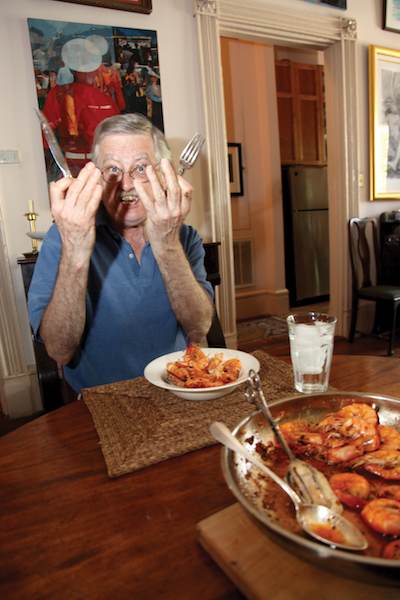“Painters mix stuff together, and you’ll find a lot of painters who are cooks because it’s an extension of this, instead of colors you’re mixing flavors. I got myself Julia Child’s Mastering the Art of French Cooking, but French cooking is like a mist before the eyes while Italian cooking is like a pat on the back. It’s a bit more rational. French cooking, a lot of it comes from the Roman period. I’ve cooked Roman recipes. Ham en croute with figs—not quite up to speed in the modern sense, but good.
The Romans did what the French did later on. They specialized in taking a fish and making it taste like chicken, or taking a chicken and making it taste like fish. In other words, they were more interested in the trickery of cooking. You take the food and change it into something that it originally isn’t. Quite frankly, I think the barbarian invasion of the Italian peninsula changed that, because the Germans were a little more practical. But the Romans liked trick food. Oysters that taste like ice cream—now, I’m kidding, but that’s what they’d do. And this survives in some way in French cooking, especially desserts. Taking coffee and flaming it, for instance. If you go to Antoine’s and get café brulot, that’s an example of that kind of drama and theatricality of cooking that the Romans really pushed.
I lost my Julia Child’s Mastering the Art of French Cooking because I had managed to crush a mouse in it. I don’t know how that happened, but I opened it up one day and there was this flattened carcass of a mouse inside.
There’s a local thing here, barbecued shrimp, and this is not that dish. This is a lot simpler. It has garlic, red hot pepper, thyme and shrimp in it. That’s all there is. The Creole method is to cook everything to death and to combine all sorts of stuff together, my friend used to call it Creole goop. There’s a fusion of flavors. Italian cooking isn’t like that. It depends upon the least amount of effort and the least amount of ingredients. At a certain age, you just can’t keep going with all those creams and butters. You also have to cook something that doesn’t take all day to do.
This I got from a recipe book that I have in here. My take on it is very simple. You always hear, ‘serve with good, crusty bread.’ But what I do is I make a toast out of this [Pepperidge Farm] whole grain whole wheat bread. I find this has a sweetness that blends in with the shrimp taste, so that’s my contribution to this dish. We’ll put this on the bottom of the bowl and serve the shrimp on top because there’s an enormous amount of juice that’s created by the sautéing. The heads exude their goop, and it creates a sauce, and after you eat the shrimp you eat the bread. People here do a lot of boiling, but all that flavor goes out into the water and you never get it.
I buy my garlic at the supermarket already peeled. And there’s a thing that happens—have you ever had sauternes [wine]? Sauternes is made from grapes that are slightly turned; they call it the noble rot, and my garlic is slightly turned too, and there’s a depth of flavor because of that. It’s kind of like anchovy. But it gets cooked, and nobody gets the runs—so far.
I’ve had enough local cooking. My dad’s 100 in June and he doesn’t like anything anymore. He only likes his mother’s cooking. My grandmother made her own noodles, and great roasts and gravies. Her gravies were like a perfume. They were so good you could inhale them. My dad says the old-time cooking is gone; he says it’s all changed and I can see why, because the kids who go to culinary school learn to prepare food academically. It’s not neighborhood cooking anymore.
A friend of mine came over for dinner and she doesn’t like to eat with her fingers. She ate my shrimp with a knife and fork. I’m not recommending this, but it’s an interesting experience. So that’s how we do it now. We tell people, ‘Go ahead and use your fingers, but we’re going to use a knife and fork.’ [laughs]
I serve this to everybody that comes here. There’s no one who’s escaped it. Even my Anglo-Saxon friend who doesn’t like to eat with her fingers.
You don’t want to eat shrimp uncooked. I have eaten uncooked shrimp. There was a sushi bar over here and I said, ‘I want to try something I’ve never had.’ Shrimp, served raw. It was like eating snot. Jesus! It was the worst thing I’d ever put in my mouth. Amazing what a little heat will do.”
George Schmidt’s BBQ Shrimp
3/4 cup olive oil
1 head garlic, minced
1 teaspoon thyme
1 teaspoon red pepper flakes
2 pounds fresh shrimp, heads on
1 teaspoon coarse sea salt
Heat oil in a large skillet. Sauté garlic, thyme and red pepper flakes for a minute. Add shrimp. Sauté over medium to high heat for two to three minutes; cover and continue to cook for an additional two to three minutes. Sprinkle with salt. Serve hot, with juice, over whole grain toast.





